Group rehearsal – week 1
- by Marie
- in research fascia
- posted May 26, 2021
26/05/2021 – dancers/researchers present: Olivia, Zoë, Pete, and Jan-Ming online
1) Today we started with moving while attending to our body and to our attentional awareness.
2) We then had a brainstorm about fascia and biotensegrity, gathering knowledge from all our diverse approaches as dancers, osteopath, voice and manual therapist, massage therapist and sound/dance artist.
3.1) We then moved again incorporating the collective knowledge we gathered about fascia, and observing in which way it makes us move. We included the possibility of drawing and writing at any point as a way of documenting.
3.2) Keeping on our individual approach and understanding of fascia, we then shifted the focus towards the fascia and connective tissue between us.
Drawing by Olivia
Drawing by Zoë
4) Sharing: we each verbally shared our process, and feedback on the experience of moving with fascia. Some feedbacks are:
– Balancer: sense of cohesion within the group. We are a whole organism, the group is a body. Sense of trust.
This cohesion translated either as mirroring or contrasting, but not opposing. (Difference with a dance improvisation where there would be disruption.) Feel in tune with when to go with the group, or when to suggest something else.
– Feeling held by the space.
– Perception of safety, feeling held and contained by the fascial web. Relating to the nervous system, fascia is the mediator.
– Noticing that the tensegrity toy model I brought is very different to the myofascial network. The model doesn’t show the muscles. Whereas in the body nothing can happen if there is no pre-tensing state (since fascia surrounds muscles, there needs to be a muscular engagement or tonicity). Muscles and fascia act in synergy.
– Momentum is key to attend to the sensory system.
– Sense of containment: helps perceiving boundaries.
– Play with vision and breath: inhale as a pre-tensing state, opening to the outer world, relating to the sympathetic nervous system (sense of alertness). Exhale relating to the peripheral vision, softer focus, the parasympathetic nervous system (digestive state).
– Agency and interdependency: the connection amongst us is there. No need to force or create the connection. We don’t need to create a common vocabulary but we can co-exist, have different activities and still be in relation.
– Music: hang drum feels like a resonance of the fascia. Music can also distract. Also feel the need to push against it in order to find space. Music can be the fascia between people.
– Discontinuous compression floating in continuous tension (biotensegrity): suggests a non-dualistic relationship. The ‘edge of me’ is continuous, my ‘senses’ are continuous.
– Experiencing the rehearsal online: ‘my limit is the knowledge of my body, our collective knowledge, and also my resilience’.
– If I can’t hear or see, how do I connect? I know that we all have a body. I connect through memory, memory of the space and shared moment. I give space and trust to what I don’t know.
– If not enough space is given then it can become hierarchical.
– The memory of the space.
– Bounciness, weightlessness. Inwardness. Sponge out: compression of the tissue.
Drawing by Pete
– Lines going out: myofascial lines reaching out of the structure. And can in turn connect to the external architecture.
– Fascia in stillness: possibility to open and be.
– Tensegrity is relational: it connects to the earth. For example if I twist, what limits my twist is the anchored feet in the earth. Our limitation comes from the friction forces and our relation with the ground.
– Harmony, hierarchy: harmony is there. Fascia creates cohesiveness. Does it create harmony? Is harmony cultural?
– Communication: responsive, supportive. Counterpoint. From stillness to traveling forces passing through the group. If I don’t move, the communication is lessened. It is like turning the volume up and down.
– Loading engages the muscles, builds up heat and preparation.
27/05/2021 Marie and Pete
Working with touch, we used the biotensegrity model as an image to inform us on what it is to be a biotensegrity structure: how the forces spread evenly throughout the structure, keeping integrity while bearing load and not collapsing, bouncing back to the original shape.
Few thoughts came to me (Marie):
– ‘Integrity is linked to integration, which seems to require time, a kind of digestive, parasympathetic time.’
– ‘I notice how I am used to follow the touch in the direction given, offering little resistance. It may be a pattern I gained through improvising. The bouncing back to the original shape requires more attention and tonicity in the body.’
– ‘The ‘bouncing back to the shape effect’ triggers few thoughts: where is the limit or boundary of being able to resist and come back, and is this bouncing back superficial? In the same way A.C. Albright describes the physiological properties of fascia as a metaphor for resilience in which there is no bouncing back, but the capacity to recover quickly from difficulties (How to Land, 2019, p.141).’
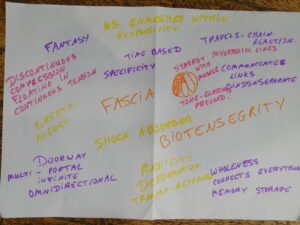
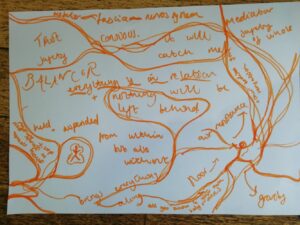
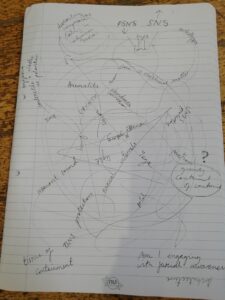
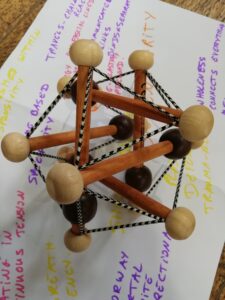
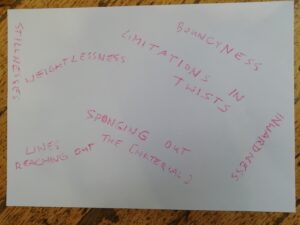
Recent Comments